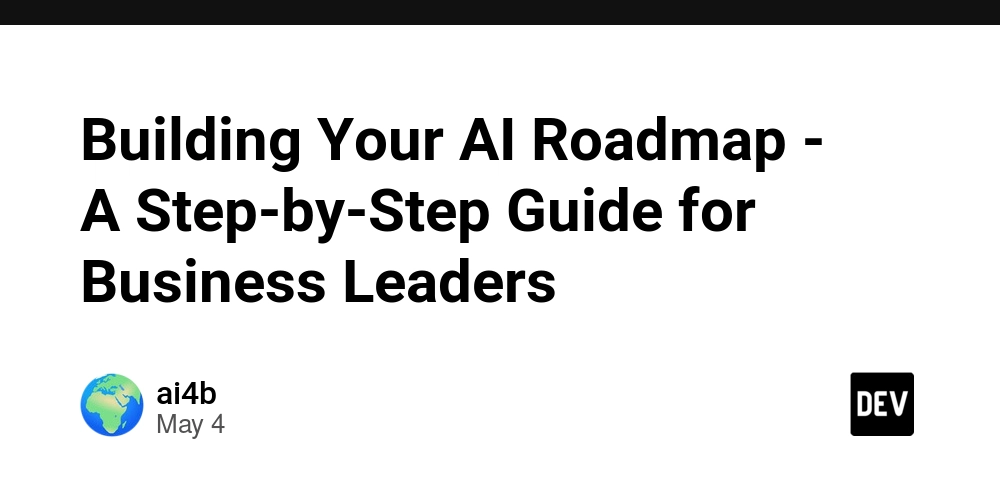Building Your AI Roadmap: A Step-by-Step Guide for Business Leaders
Executive Summary This comprehensive guide provides business leaders with a structured approach to developing and implementing an AI strategy within their organizations. From initial assessment to full-scale implementation, this roadmap offers practical insights, best practices, and actionable steps to harness AI's transformative potential while managing associated risks. 1. Introduction: The AI Imperative for Modern Businesses Artificial Intelligence (AI) has evolved from a futuristic concept to a critical business differentiator. As we progress through the 2020s, organizations that effectively integrate AI into their operations gain significant competitive advantages through enhanced efficiency, improved decision-making, and innovative customer experiences. However, the path to AI adoption remains challenging for many organizations. Business leaders often struggle with identifying the right opportunities, securing appropriate resources, building necessary capabilities, and managing implementation complexities. This guide addresses these challenges by providing a structured framework for developing a comprehensive AI roadmap tailored to your organization's specific needs and objectives. An effective AI roadmap serves multiple purposes: It aligns AI initiatives with core business objectives It provides a structured approach to prioritizing AI investments It establishes clear governance for AI development and deployment It helps manage organizational change associated with AI adoption It creates accountability through defined metrics and success criteria The following sections outline a step-by-step process for building this roadmap, empowering business leaders to navigate the AI landscape with confidence and purpose. 2. Assessing Your Organization's AI Readiness Before embarking on any AI initiative, it's essential to evaluate your organization's current capabilities, resources, and cultural readiness for AI adoption. 2.1 Data Infrastructure Assessment AI systems require robust data foundations. Assess your current state by examining: Data Availability and Quality: Inventory your data assets across departments and systems. Evaluate data completeness, accuracy, consistency, and timeliness. Identify gaps in data collection and storage that might impede AI development. Data Accessibility: Determine how easily relevant data can be accessed, integrated, and shared across teams. Siloed data represents a significant barrier to effective AI implementation. Data Governance: Review existing policies and procedures for data management, security, privacy, and compliance. Strong governance is essential for responsible AI development. Technical Infrastructure: Evaluate your computing resources, storage systems, and networking capabilities. AI, particularly machine learning, often requires substantial computational resources. 2.2 Skills and Capabilities Assessment AI implementation requires specialized expertise across multiple domains: Technical AI Skills: Assess internal capabilities in data science, machine learning engineering, AI research, and related technical fields. Complementary Skills: Evaluate expertise in areas that support AI implementation, including business analysis, project management, change management, and ethics. Leadership Understanding: Gauge executive-level understanding of AI concepts, opportunities, and limitations. Leadership support is critical for successful AI adoption. Partner Ecosystem: Map potential external partners, including technology vendors, consultants, and academic institutions, who could supplement internal capabilities. 2.3 Organizational Culture Assessment Cultural factors significantly impact AI adoption success: Innovation Appetite: Evaluate your organization's willingness to experiment, tolerate failure, and embrace new approaches. Data-Driven Decision Making: Assess whether decisions are typically made based on data and analysis versus intuition or tradition. Cross-Functional Collaboration: Determine how effectively different departments work together, as AI initiatives often span traditional organizational boundaries. Change Readiness: Gauge how well your organization has navigated previous technology transitions and organization-wide changes. 2.4 Creating Your Baseline Readiness Profile Consolidate your assessments into a comprehensive baseline profile that highlights: Areas of organizational strength to leverage Critical gaps that require attention Potential quick wins based on existing capabilities Longer-term infrastructure and capability needs This baseline provides the foundation for subsequent roadmap development, ensuring your AI strategy builds on existing strengths while systematically addressing gaps. 3. Identifying AI Opportunities Aligned with Business Objectives With a clear understanding of your organization's AI readiness, the next step is to i

Executive Summary
This comprehensive guide provides business leaders with a structured approach to developing and implementing an AI strategy within their organizations. From initial assessment to full-scale implementation, this roadmap offers practical insights, best practices, and actionable steps to harness AI's transformative potential while managing associated risks.
1. Introduction: The AI Imperative for Modern Businesses
Artificial Intelligence (AI) has evolved from a futuristic concept to a critical business differentiator. As we progress through the 2020s, organizations that effectively integrate AI into their operations gain significant competitive advantages through enhanced efficiency, improved decision-making, and innovative customer experiences.
However, the path to AI adoption remains challenging for many organizations. Business leaders often struggle with identifying the right opportunities, securing appropriate resources, building necessary capabilities, and managing implementation complexities. This guide addresses these challenges by providing a structured framework for developing a comprehensive AI roadmap tailored to your organization's specific needs and objectives.
An effective AI roadmap serves multiple purposes:
- It aligns AI initiatives with core business objectives
- It provides a structured approach to prioritizing AI investments
- It establishes clear governance for AI development and deployment
- It helps manage organizational change associated with AI adoption
- It creates accountability through defined metrics and success criteria
The following sections outline a step-by-step process for building this roadmap, empowering business leaders to navigate the AI landscape with confidence and purpose.
2. Assessing Your Organization's AI Readiness
Before embarking on any AI initiative, it's essential to evaluate your organization's current capabilities, resources, and cultural readiness for AI adoption.
2.1 Data Infrastructure Assessment
AI systems require robust data foundations. Assess your current state by examining:
Data Availability and Quality: Inventory your data assets across departments and systems. Evaluate data completeness, accuracy, consistency, and timeliness. Identify gaps in data collection and storage that might impede AI development.
Data Accessibility: Determine how easily relevant data can be accessed, integrated, and shared across teams. Siloed data represents a significant barrier to effective AI implementation.
Data Governance: Review existing policies and procedures for data management, security, privacy, and compliance. Strong governance is essential for responsible AI development.
Technical Infrastructure: Evaluate your computing resources, storage systems, and networking capabilities. AI, particularly machine learning, often requires substantial computational resources.
2.2 Skills and Capabilities Assessment
AI implementation requires specialized expertise across multiple domains:
Technical AI Skills: Assess internal capabilities in data science, machine learning engineering, AI research, and related technical fields.
Complementary Skills: Evaluate expertise in areas that support AI implementation, including business analysis, project management, change management, and ethics.
Leadership Understanding: Gauge executive-level understanding of AI concepts, opportunities, and limitations. Leadership support is critical for successful AI adoption.
Partner Ecosystem: Map potential external partners, including technology vendors, consultants, and academic institutions, who could supplement internal capabilities.
2.3 Organizational Culture Assessment
Cultural factors significantly impact AI adoption success:
Innovation Appetite: Evaluate your organization's willingness to experiment, tolerate failure, and embrace new approaches.
Data-Driven Decision Making: Assess whether decisions are typically made based on data and analysis versus intuition or tradition.
Cross-Functional Collaboration: Determine how effectively different departments work together, as AI initiatives often span traditional organizational boundaries.
Change Readiness: Gauge how well your organization has navigated previous technology transitions and organization-wide changes.
2.4 Creating Your Baseline Readiness Profile
Consolidate your assessments into a comprehensive baseline profile that highlights:
- Areas of organizational strength to leverage
- Critical gaps that require attention
- Potential quick wins based on existing capabilities
- Longer-term infrastructure and capability needs
This baseline provides the foundation for subsequent roadmap development, ensuring your AI strategy builds on existing strengths while systematically addressing gaps.
3. Identifying AI Opportunities Aligned with Business Objectives
With a clear understanding of your organization's AI readiness, the next step is to identify specific AI opportunities that align with core business objectives.
3.1 Business Objective Clarification
Begin by clearly articulating your organization's strategic priorities:
Strategic Imperatives: Identify the 3-5 most critical business objectives, such as revenue growth, cost reduction, customer experience improvement, or market expansion.
Performance Gaps: For each objective, determine current performance levels and desired targets, quantifying the gap where possible.
Value Drivers: Analyze the key factors that influence each objective, creating a map of potential intervention points for AI solutions.
3.2 AI Opportunity Mapping
For each business objective, identify potential AI applications:
Operational Efficiency: Opportunities to automate routine processes, optimize resource allocation, reduce costs, and increase throughput.
Enhanced Decision Making: Areas where data-driven insights could improve strategic, tactical, or operational decisions.
Customer Experience: Touchpoints where personalization, prediction, or automation could enhance customer satisfaction and loyalty.
Product and Service Innovation: Possibilities for AI-enhanced offerings or entirely new AI-powered products and services.
Risk Management: Operations where AI could help predict, identify, or mitigate various business risks.
3.3 Market and Competitive Analysis
Supplement internal opportunity identification with external perspectives:
Industry Benchmarking: Research AI applications that competitors and industry leaders are successfully implementing.
Cross-Industry Inspiration: Identify successful AI applications in other industries that might transfer to your context.
Emerging Technology Assessment: Evaluate emerging AI capabilities and their potential relevance to your business challenges.
3.4 Opportunity Validation
For each identified opportunity, conduct initial validation:
Business Case Elements: Develop preliminary estimates of potential benefits, required investments, and implementation timeframes.
Technical Feasibility: Evaluate alignment with your current data assets, infrastructure, and capabilities.
Organizational Alignment: Assess the fit with existing processes, systems, and cultural factors.
Risk Assessment: Identify potential implementation challenges, dependencies, and mitigation strategies.
3.5 Opportunity Portfolio Development
Consolidate validated opportunities into a comprehensive portfolio:
Opportunity Documentation: Create standardized profiles for each opportunity, documenting key aspects like business alignment, estimated impact, and implementation considerations.
Portfolio Visualization: Map opportunities across dimensions such as business impact, implementation complexity, and strategic alignment to facilitate subsequent prioritization.
This systematic opportunity identification process ensures that AI initiatives are firmly anchored in business value rather than technology novelty.
4. Prioritizing AI Initiatives and Building Your Roadmap
With a portfolio of potential AI opportunities identified, the next crucial step is prioritizing these initiatives to create a sequenced roadmap.
4.1 Prioritization Framework Development
Establish clear criteria for evaluating and ranking AI opportunities:
Strategic Alignment: Degree to which the initiative supports core business objectives and strategic priorities.
Business Impact: Estimated value creation through revenue enhancement, cost reduction, risk mitigation, or other performance improvements.
Technical Feasibility: Alignment with current data assets, required technology complexity, and technical implementation challenges.
Organizational Readiness: Fit with existing processes, required organizational changes, and cultural alignment.
Resource Requirements: Needed investments in technology, talent, and organizational change.
Time to Value: Expected duration until meaningful value begins to be realized.
Risk Profile: Implementation risks, regulatory considerations, reputation impacts, and other risk dimensions.
Dependency Analysis: Interrelationships between initiatives and dependencies on other projects or capabilities.
4.2 Initiative Scoring and Ranking
Apply your prioritization framework to evaluate each AI opportunity:
Structured Assessment: Score each opportunity against prioritization criteria using a consistent methodology.
Weighted Scoring: Consider applying weights to criteria based on their relative importance to your organization.
Portfolio Analysis: Visualize initiatives across multiple dimensions to identify clusters of opportunities with similar characteristics.
Stakeholder Input: Gather perspectives from different organizational functions to ensure diverse viewpoints inform prioritization.
4.3 Roadmap Development
Organize prioritized initiatives into a coherent, time-phased roadmap:
Horizon Planning: Structure your roadmap across multiple time horizons:
- Near-term (0-6 months): Quick wins and foundation-building activities
- Mid-term (6-18 months): Core strategic initiatives
- Long-term (18+ months): Transformational opportunities requiring substantial groundwork
Initiative Sequencing: Determine logical ordering based on dependencies, resource constraints, and value creation.
Capability Building Integration: Incorporate necessary capability development activities alongside specific AI initiatives.
Milestone Definition: Establish clear milestones, decision points, and success criteria throughout the roadmap.
4.4 Resource Planning
Develop high-level resource plans to support roadmap execution:
Budget Estimation: Project required financial investments across roadmap phases.
Talent Requirements: Identify needed skills and capabilities, with plans for sourcing through hiring, training, or partnerships.
Technology Infrastructure: Outline necessary infrastructure enhancements to support AI initiatives.
Governance Structures: Define oversight and decision-making mechanisms for roadmap management.
4.5 Roadmap Documentation and Communication
Create clear documentation and communication materials:
Executive Summary: Concise overview highlighting strategic alignment, expected impacts, and key milestones.
Detailed Roadmap: Comprehensive documentation including initiative details, resource requirements, risk assessments, and interdependencies.
Visual Representations: Timeline visualizations, impact maps, and other graphical elements to enhance understanding.
Stakeholder-Specific Materials: Tailored communications for different audiences, from executive leadership to technical teams to broader organizational stakeholders.
A well-constructed roadmap provides both strategic direction and tactical clarity, enabling effective execution while maintaining flexibility to adapt as circumstances evolve.
5. Building AI Capabilities and Infrastructure
Successful AI implementation requires developing appropriate foundational capabilities and infrastructure. This section outlines key components to address in your roadmap.
5.1 Data Foundation Development
Establish robust data practices to support AI initiatives:
Data Strategy: Develop a comprehensive approach to data collection, management, governance, and utilization aligned with AI objectives.
Data Architecture: Design and implement systems for efficient data storage, integration, and access that can support AI workloads.
Data Quality Framework: Establish processes for ensuring data accuracy, completeness, consistency, and timeliness.
Master Data Management: Implement practices for maintaining consistent definitions and structures for critical data entities.
Data Governance Implementation: Operationalize policies and procedures for data management, security, privacy, and compliance.
5.2 Technology Infrastructure Enhancement
Build or acquire necessary technology components:
Compute Resources: Determine appropriate computing platforms for AI development and deployment, considering cloud, on-premises, and hybrid options.
AI Development Environment: Establish tools, platforms, and practices for efficient AI model development and testing.
Model Operations (MLOps): Create infrastructure for deploying, monitoring, and maintaining AI models in production.
Integration Architecture: Design approaches for connecting AI systems with existing enterprise applications and workflows.
Security Framework: Implement safeguards to protect AI systems and associated data from security threats.
5.3 Talent and Organizational Capability Development
Build necessary human capabilities through multiple approaches:
AI Center of Excellence: Consider establishing a centralized team to provide expertise, governance, and support for AI initiatives across the organization.
Talent Acquisition: Develop strategies for recruiting key AI skills where necessary.
Training and Development: Create learning pathways for existing staff to develop AI-related capabilities.
Partner Ecosystem: Cultivate relationships with service providers, technology vendors, and academic institutions to supplement internal capabilities.
Change Management: Implement programs to help the organization adapt to new AI-enabled workflows and decision processes.
5.4 Governance and Ethical Framework Establishment
Create structures to guide responsible AI development and use:
AI Governance Committee: Form a cross-functional body to oversee AI initiatives and ensure alignment with organizational values and objectives.
Ethical Guidelines: Develop principles and practices for responsible AI development and deployment.
Risk Management Framework: Establish processes for identifying, assessing, and mitigating AI-specific risks.
Compliance Mechanisms: Create procedures to ensure AI systems meet relevant regulatory requirements.
Transparency Practices: Implement approaches for explaining AI operations and decisions to relevant stakeholders.
5.5 Capability Roadmap Integration
Align capability development with your AI initiative roadmap:
Capability Dependencies: Identify which capabilities must be in place to support specific AI initiatives.
Phased Development: Create a time-phased plan for building capabilities that aligns with your initiative roadmap.
Quick Wins vs. Foundation Building: Balance rapid capability development for near-term needs with systematic building of robust, scalable foundations.
By systematically addressing these capability areas alongside specific AI initiatives, organizations can build a sustainable foundation for ongoing AI adoption and value creation.
6. Implementing AI Initiatives: From Pilot to Production
Effective implementation transforms AI potential into business value. This section outlines approaches for successfully executing AI initiatives.
6.1 Implementation Methodology Selection
Choose appropriate development and deployment approaches:
Agile Implementation: Adopt iterative, incremental methodologies that enable rapid learning and adaptation, particularly well-suited to AI development's experimental nature.
Minimum Viable Product (MVP) Approach: Define the smallest implementation that delivers meaningful value, allowing for validation before full-scale deployment.
Design Thinking Integration: Incorporate human-centered design principles to ensure AI solutions effectively address user needs and workflow realities.
Phase-Gate Process: Establish clear decision points throughout implementation to evaluate progress and determine whether to proceed, adjust, or terminate initiatives.
6.2 Pilot Program Design
Structure initial implementations to maximize learning while managing risk:
Scope Definition: Carefully bound pilot implementations to focus on specific use cases, user groups, or business processes.
Success Criteria: Establish clear metrics and thresholds for evaluating pilot outcomes.
Learning Objectives: Identify key questions and assumptions to test through the pilot.
Stakeholder Involvement: Engage appropriate business and technical stakeholders to provide input and feedback throughout the pilot.
Pilot-to-Production Planning: Design pilots with eventual scaling in mind, considering how the approach might evolve for broader deployment.
6.3 AI Solution Development
Execute the technical aspects of AI implementation:
Data Preparation: Execute necessary data collection, integration, cleaning, and transformation activities.
Model Development: Build, train, and validate AI models that address the targeted business requirements.
Integration Design: Create effective connections between AI components and existing systems and workflows.
User Experience Development: Design interfaces and interactions that effectively incorporate AI capabilities into user workflows.
Testing and Validation: Rigorously test AI solutions for accuracy, reliability, performance, security, and usability.
6.4 Organizational Change Management
Address the human aspects of AI implementation:
Stakeholder Analysis: Identify groups affected by the AI initiative and understand their perspectives and concerns.
Communication Strategy: Develop targeted communications to build awareness, understanding, and buy-in among affected stakeholders.
Training Program: Create and deliver appropriate training for users, administrators, and other relevant roles.
Process Redesign: Update business processes to effectively incorporate AI capabilities.
Incentive Alignment: Ensure performance metrics and incentives support adoption of the new AI-enabled approaches.
6.5 Scaling Successfully
Expand successful pilots to achieve broader impact:
Scaling Assessment: Evaluate pilot results and determine appropriate scaling strategy.
Infrastructure Enhancement: Address any technical limitations identified during the pilot that could impede scaling.
Organizational Expansion: Systematically extend the solution to additional business units, user groups, or geographical areas.
Economies of Scale: Identify opportunities to leverage components across multiple AI initiatives to increase efficiency.
Continuous Improvement: Establish mechanisms for ongoing refinement based on expanded usage and feedback.
6.6 Production Management
Ensure reliable ongoing operation of AI systems:
Model Monitoring: Implement approaches for tracking AI model performance and detecting potential issues.
Maintenance Processes: Establish procedures for regular updates, retraining, and refinement of AI systems.
Support Structures: Create appropriate technical and user support mechanisms.
Performance Tracking: Monitor business outcomes and value creation from deployed AI solutions.
Knowledge Management: Capture and share implementation lessons to inform future initiatives.
Thoughtful implementation approaches balance technical excellence with organizational adoption considerations, maximizing the probability of successful outcomes and sustainable value creation.
7. Measuring Success and Managing the AI Portfolio
Effective measurement and portfolio management are essential for sustaining AI value creation over time.
7.1 Success Measurement Framework
Develop comprehensive approaches to evaluating AI initiatives:
Business Impact Metrics: Establish measures directly connected to the business objectives driving each initiative, such as revenue increase, cost reduction, customer satisfaction improvement, or risk reduction.
AI Performance Metrics: Track technical performance measures like prediction accuracy, processing efficiency, or system reliability.
Adoption Metrics: Monitor usage patterns, user satisfaction, and other indicators of organizational uptake.
Investment Efficiency: Calculate returns on AI investments to guide future resource allocation decisions.
Capability Development Metrics: Assess progress in building organizational capabilities that enable ongoing AI success.
7.2 Measurement Implementation
Operationalize your measurement framework:
Baseline Establishment: Document pre-implementation performance levels for key metrics to enable accurate impact assessment.
Data Collection Mechanisms: Implement systems and processes to gather relevant measurement data.
Reporting Cadence: Determine appropriate frequencies for different types of measurement and reporting.
Dashboard Development: Create visualization tools that make performance transparent to stakeholders.
Analysis Practices: Establish processes for interpreting measurement data and generating actionable insights.
7.3 Portfolio Management
Manage your collection of AI initiatives as a cohesive portfolio:
Regular Review Cadence: Establish consistent cycles for evaluating portfolio performance and making adjustment decisions.
Resource Reallocation: Develop mechanisms for shifting resources from underperforming initiatives to more promising opportunities.
Initiative Dependencies: Manage interconnections between initiatives to ensure coordinated progress.
Portfolio Balancing: Maintain an appropriate mix of initiatives across dimensions such as risk profile, time horizon, and business area.
New Opportunity Integration: Create processes for evaluating and incorporating new AI opportunities as they emerge.
7.4 Learning and Adaptation
Build organizational capabilities for continuous improvement:
Post-Implementation Reviews: Conduct structured assessments after major milestones to capture lessons learned.
Knowledge Sharing Mechanisms: Establish practices for disseminating insights across AI initiatives and teams.
Capability Enhancement: Continuously refine AI implementation approaches based on experience.
Emerging Technology Monitoring: Maintain awareness of AI advancement and assess implications for your roadmap.
Strategic Reassessment: Periodically revisit fundamental assumptions and strategic direction to ensure ongoing alignment with organizational priorities.
Rigorous measurement and active portfolio management transform AI from isolated projects into a strategic capability that generates sustained competitive advantage.
8. Managing AI Risks and Ethical Considerations
Responsible AI implementation requires proactive identification and management of associated risks and ethical considerations.
8.1 AI Risk Framework
Develop a structured approach to identifying and addressing AI-specific risks:
Accuracy and Performance Risks: Address potential issues with AI system reliability, precision, and consistency.
Security Vulnerabilities: Identify potential weaknesses in AI systems that could be exploited by malicious actors.
Data Privacy Concerns: Manage risks related to the use of sensitive personal or proprietary information.
Algorithmic Bias: Recognize and mitigate potential unfair discrimination in AI system outputs.
Explainability Challenges: Address issues related to understanding and explaining AI decision processes.
Regulatory Compliance: Ensure adherence to applicable laws and regulations governing AI systems.
Dependency Risks: Manage vulnerabilities created by reliance on AI systems for critical business functions.
Third-Party Risks: Assess exposures created through vendor relationships and external data sources.
8.2 Ethical Framework Development
Establish principles and practices for responsible AI development and use:
Ethical Principles: Articulate core values that will guide AI initiatives, such as fairness, transparency, privacy, and human welfare.
Governance Structures: Create oversight mechanisms to ensure adherence to ethical principles.
Ethics by Design: Integrate ethical considerations throughout the AI development lifecycle rather than addressing them as an afterthought.
Stakeholder Inclusion: Ensure diverse perspectives inform ethical decision-making.
Transparency Commitments: Determine appropriate levels of disclosure about AI operations and impacts to different stakeholders.
8.3 Risk Assessment and Mitigation
Implement practical approaches for managing identified risks:
Risk Assessment Process: Establish a systematic methodology for evaluating risks associated with specific AI initiatives.
Mitigation Strategy Development: Create targeted approaches for addressing prioritized risks.
Testing and Validation: Implement rigorous testing to identify potential issues before deployment.
Ongoing Monitoring: Establish mechanisms for detecting emerging risks in operational AI systems.
Incident Response Planning: Develop procedures for responding to AI system failures or ethical breaches.
8.4 Compliance Management
Ensure AI initiatives meet relevant regulatory requirements:
Regulatory Landscape Monitoring: Maintain awareness of evolving AI regulations across relevant jurisdictions.
Compliance Review Process: Integrate regulatory considerations into AI development and deployment workflows.
Documentation Practices: Maintain appropriate records of compliance-related activities and decisions.
Engagement with Regulators: When appropriate, participate in regulatory discussions to shape evolving standards.
8.5 Responsible AI Culture
Foster organizational awareness and commitment to responsible AI practices:
Leadership Commitment: Ensure executive support for prioritizing responsible AI approaches, even when they require additional resources or time.
Training and Awareness: Develop educational programs to build understanding of AI ethics and risk management across the organization.
Incentive Alignment: Ensure performance metrics and rewards support responsible AI development and use.
Open Discussion: Create psychological safety for raising concerns about potential ethical issues or risks.
By systematically addressing risk and ethical dimensions, organizations can build trust with stakeholders and avoid potentially significant negative consequences while capturing AI's benefits.
9. Future-Proofing Your AI Strategy
The AI landscape continues to evolve rapidly. This section addresses approaches for maintaining an effective AI strategy amid ongoing technological and business change.
9.1 Technology Evolution Monitoring
Establish mechanisms to track relevant AI advancements:
Technological Trend Analysis: Maintain regular assessment of emerging AI capabilities and their potential business applications.
Academic and Research Engagement: Develop connections with AI research communities to gain early insights into developing technologies.
Vendor Relationship Management: Cultivate partnerships with technology providers that provide visibility into product roadmaps and emerging offerings.
Experimentation Program: Allocate resources for small-scale exploration of promising new technologies without immediate business applications.
9.2 Scenario Planning
Prepare for alternative future environments:
Critical Uncertainty Identification: Determine key variables that could significantly impact your AI strategy, such as technology advancement rates, regulatory developments, competitive dynamics, or customer expectations.
Scenario Development: Create multiple plausible future scenarios based on different combinations of these uncertainties.
Strategy Robustness Analysis: Assess how well your current roadmap would perform across these scenarios.
Contingency Planning: Develop alternative approaches that could be implemented if certain scenarios materialize.
9.3 Organizational Adaptability
Build capabilities for ongoing evolution:
Learning Culture: Foster curiosity, experimentation, and knowledge-sharing that enable rapid adaptation to new opportunities and challenges.
Modular Architecture: Design systems and processes with flexibility and reconfigurability in mind.
Strategic Partnerships: Develop relationships that can provide access to complementary capabilities as needs evolve.
Talent Strategy: Create approaches for continuously refreshing organizational skills aligned with emerging AI directions.
9.4 Strategic Review Process
Establish disciplined procedures for strategy reassessment:
Regular Review Cadence: Schedule periodic comprehensive reviews of your AI strategy and roadmap.
Trigger Events: Identify specific developments (technological, competitive, regulatory, etc.) that would prompt off-cycle strategy reassessment.
Fresh Perspective Integration: Incorporate insights from across and beyond the organization to challenge established thinking.
Strategic Pivoting Process: Develop protocols for making major strategic shifts when warranted by changing circumstances.
9.5 Sustainable Advantage Creation
Focus on durable sources of AI-enabled competitive differentiation:
Proprietary Data Assets: Identify and develop unique data resources that can provide lasting advantages.
Domain-Specific AI: Build specialized AI capabilities tailored to your industry and business context.
Complementary Capabilities: Develop organizational strengths that enhance AI value, such as change management excellence or superior implementation skill.
Ecosystem Positioning: Establish advantageous positions within broader business ecosystems that incorporate AI.
By incorporating these future-oriented practices, organizations can increase the durability and adaptability of their AI strategy amid continuous change.
10. Conclusion: Leading the AI-Enabled Organization
Successfully implementing your AI roadmap requires more than technical execution—it demands effective leadership that navigates organizational, cultural, and strategic dimensions.
Key Leadership Imperatives
Strategic Vision Maintenance: Consistently connect AI initiatives to broader business strategy, ensuring that technological means remain aligned with organizational ends.
Resource Commitment: Secure and sustain the financial, human, and organizational resources necessary for successful AI implementation.
Balanced Perspective: Maintain realistic expectations that acknowledge both AI's transformative potential and its practical limitations.
Cross-Functional Integration: Break down silos between technical teams and business units to ensure AI solutions address real business needs.
Cultural Leadership: Model and encourage the data-driven mindset, experimental approach, and collaborative practices that enable AI success.
Ethical Stewardship: Demonstrate commitment to responsible AI development and use, even when it requires additional effort or expense.
Continuous Learning: Foster individual and organizational growth that enables ongoing adaptation to evolving AI capabilities and applications.
Final Thoughts
Building and implementing an AI roadmap is a journey rather than a destination. The specific technologies, applications, and practices will continuously evolve, but the fundamental approach outlined in this guide provides a durable framework for navigating this dynamic landscape.
By connecting AI initiatives to clear business objectives, systematically building necessary capabilities, implementing with both technical rigor and organizational sensitivity, and continuously learning and adapting, your organization can realize sustainable value from AI investments.
The most successful AI-enabled organizations view artificial intelligence not as a separate technical domain but as an integrated capability that permeates strategic thinking and operational execution. By developing and executing a comprehensive AI roadmap, you create the foundation for this integration—positioning your organization to thrive in an increasingly AI-influenced business environment.
Appendix A: AI Roadmap Templates and Tools
A.1 AI Readiness Assessment Template
| Dimension | Assessment Areas | Current State | Target State | Gap Analysis |
|---|---|---|---|---|
| Data Infrastructure | Data availability Data quality Data accessibility Data governance Technical infrastructure |
|||
| Skills & Capabilities | Technical AI skills Complementary skills Leadership understanding Partner ecosystem |
|||
| Organizational Culture | Innovation appetite Data-driven decision making Cross-functional collaboration Change readiness |
A.2 AI Opportunity Validation Template
| Dimension | Questions to Address |
|---|---|
| Strategic Alignment | How does this opportunity support our strategic objectives? Which specific business goals will it advance? |
| Value Potential | What specific benefits do we expect? How will we measure success? What is the estimated ROI? |
| Technical Feasibility | Do we have the necessary data? What technical capabilities are required? What integration points must be addressed? |
| Organizational Impact | Which processes and roles will be affected? What organizational changes will be required? How will we manage the transition? |
| Risk Assessment | What are the primary implementation risks? Are there ethical or regulatory considerations? How might this affect our reputation or customer trust? |
| Resource Requirements | What financial investment is needed? What skills and capabilities are required? What timeline should we expect? |
A.3 AI Initiative Prioritization Matrix
| Criteria | Weight | Initiative 1 Score (1-5) |
Initiative 1 Weighted |
Initiative 2 Score (1-5) |
Initiative 2 Weighted |
Initiative 3 Score (1-5) |
Initiative 3 Weighted |
|---|---|---|---|---|---|---|---|
| Strategic Alignment | 20% | ||||||
| Business Impact | 25% | ||||||
| Technical Feasibility | 15% | ||||||
| Organizational Readiness | 10% | ||||||
| Resource Requirements | 10% | ||||||
| Time to Value | 10% | ||||||
| Risk Profile | 10% | ||||||
| TOTAL | 100% |
A.4 AI Roadmap Visualization Template
| Time Horizon | AI Initiatives | Capability Building Activities | Key Milestones |
|---|---|---|---|
| Near-term (0-6 months) |
|||
| Mid-term (6-18 months) |
|||
| Long-term (18+ months) |
A.5 AI Success Measurement Framework Template
| Metric Category | Specific Metrics | Measurement Methodology | Target | Baseline | Current | Reporting Frequency |
|---|---|---|---|---|---|---|
| Business Impact | ||||||
| AI Performance | ||||||
| Adoption | ||||||
| Investment Efficiency | ||||||
| Capability Development |
Appendix B: Glossary of AI Terms for Business Leaders
Artificial Intelligence (AI): Computer systems capable of performing tasks that typically require human intelligence, such as visual perception, speech recognition, decision-making, and language translation.
Machine Learning (ML): A subset of AI that involves training algorithms to learn patterns from data and make predictions or decisions without explicit programming for each specific task.
Deep Learning: A specialized type of machine learning using neural networks with multiple layers (deep neural networks) to model complex patterns in data.
Natural Language Processing (NLP): AI techniques that enable computers to understand, interpret, and generate human language.
Computer Vision: AI capabilities that allow systems to interpret and understand visual information from the world.
Predictive Analytics: The use of data, statistical algorithms, and machine learning techniques to identify the likelihood of future outcomes based on historical data.
Supervised Learning: A machine learning approach where algorithms are trained on labeled data (with known outcomes) to make predictions for new, unseen data.
Unsupervised Learning: Machine learning techniques that find patterns or structures in data without labeled examples.
Reinforcement Learning: A machine learning approach where an agent learns to make decisions by performing actions and receiving rewards or penalties.
Neural Network: A computing system inspired by biological neural networks, consisting of interconnected nodes ("neurons") that process and transmit information.
Algorithm: A step-by-step procedure or formula for solving a problem or accomplishing a task, forming the basis of AI system operations.
Data Mining: The process of discovering patterns, anomalies, and relationships in large datasets to extract useful information.
Bias (in AI): Systematic errors in AI systems that produce unfair or discriminatory outcomes for particular groups of people.
Model: A mathematical representation of a real-world process, trained on data to make predictions or decisions.
Training Data: The dataset used to teach a machine learning model to make predictions or decisions.
Inference: The process of using a trained AI model to make predictions or decisions based on new input data.
MLOps (Machine Learning Operations): Practices that aim to deploy and maintain machine learning models in production reliably and efficiently.
Generative AI: AI systems capable of creating new content, such as text, images, music, or synthetic data.
Explainable AI (XAI): Approaches and methods that make AI system decisions more understandable and interpretable to humans.
AI Ethics: The field concerned with ensuring AI systems are designed and used in ways that are beneficial, fair, transparent, and aligned with human values.
Appendix C: References and Further Reading
Books
Davenport, T. H., & Ronanki, R. (2023). The AI Advantage: How to Put the Artificial Intelligence Revolution to Work. MIT Press.
Agrawal, A., Gans, J., & Goldfarb, A. (2022). Prediction Machines: The Simple Economics of Artificial Intelligence. Harvard Business Review Press.
Ng, A. (2021). AI Transformation Playbook: How to Lead Your Company into the AI Era. Landing AI.
Iansiti, M., & Lakhani, K. R. (2023). Competing in the Age of AI: Strategy and Leadership When Algorithms and Networks Run the World. Harvard Business Review Press.
Research Reports
McKinsey Global Institute (2024). Notes from the AI frontier: Applications and value of deep learning.
Gartner (2024). Top Strategic Technology Trends: Practical Applications of Artificial Intelligence.
Deloitte (2023). State of AI in the Enterprise. Deloitte Insights.
MIT Sloan Management Review & Boston Consulting Group (2024). Winning With AI: Pioneers Combine Strategy, Organizational Behavior, and Technology.
Articles
Fountaine, T., McCarthy, B., & Saleh, T. (2022). "Building the AI-Powered Organization." Harvard Business Review, July-August 2022.
Davenport, T. H. (2023). "What Companies Are Getting Wrong About AI." MIT Sloan Management Review, Spring 2023.
Brynjolfsson, E., & McAfee, A. (2023). "The Business of Artificial Intelligence." Harvard Business Review, July 2023.
Chui, M., & Malhotra, S. (2024). "Notes from the AI frontier: Insights from hundreds of use cases." McKinsey Quarterly, April 2024.
Online Resources
AI Business School (Microsoft): https://www.microsoft.com/ai/ai-business-school
Google AI Resource Center: https://ai.google/education/
AI Readiness Assessment Tool (World Economic Forum): https://www.weforum.org/ai-toolkit/
O'Reilly AI Learning Platform: https://www.oreilly.com/ai/
AI Ethics Guidelines Global Inventory: https://algorithmwatch.org/en/ai-ethics-guidelines-global-inventory/





































































































































































![[The AI Show Episode 145]: OpenAI Releases o3 and o4-mini, AI Is Causing “Quiet Layoffs,” Executive Order on Youth AI Education & GPT-4o’s Controversial Update](https://www.marketingaiinstitute.com/hubfs/ep%20145%20cover.png)




























































































































![[DEALS] Microsoft 365: 1-Year Subscription (Family/Up to 6 Users) (23% off) & Other Deals Up To 98% Off – Offers End Soon!](https://www.javacodegeeks.com/wp-content/uploads/2012/12/jcg-logo.jpg)




![From Art School Drop-out to Microsoft Engineer with Shashi Lo [Podcast #170]](https://cdn.hashnode.com/res/hashnode/image/upload/v1746203291209/439bf16b-c820-4fe8-b69e-94d80533b2df.png?#)




















![Re-designing a Git/development workflow with best practices [closed]](https://i.postimg.cc/tRvBYcrt/branching-example.jpg)




















































































(1).jpg?#)






























_Inge_Johnsson-Alamy.jpg?width=1280&auto=webp&quality=80&disable=upscale#)































































































![The Material 3 Expressive redesign of Google Clock leaks out [Gallery]](https://i0.wp.com/9to5google.com/wp-content/uploads/sites/4/2024/03/Google-Clock-v2.jpg?resize=1200%2C628&quality=82&strip=all&ssl=1)
![What Google Messages features are rolling out [May 2025]](https://i0.wp.com/9to5google.com/wp-content/uploads/sites/4/2023/12/google-messages-name-cover.png?resize=1200%2C628&quality=82&strip=all&ssl=1)













![New Apple iPad mini 7 On Sale for $399! [Lowest Price Ever]](https://www.iclarified.com/images/news/96096/96096/96096-640.jpg)
![Apple to Split iPhone Launches Across Fall and Spring in Major Shakeup [Report]](https://www.iclarified.com/images/news/97211/97211/97211-640.jpg)
![Apple to Move Camera to Top Left, Hide Face ID Under Display in iPhone 18 Pro Redesign [Report]](https://www.iclarified.com/images/news/97212/97212/97212-640.jpg)
![Apple Developing Battery Case for iPhone 17 Air Amid Battery Life Concerns [Report]](https://www.iclarified.com/images/news/97208/97208/97208-640.jpg)


































































































